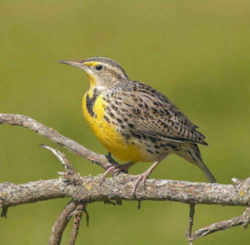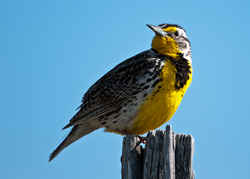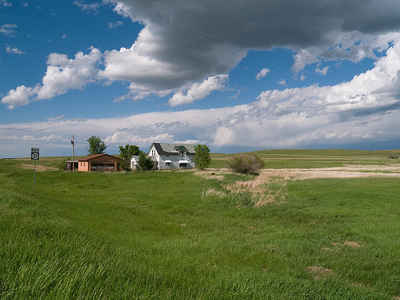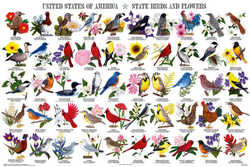North Dakota State Bird
Western Meadowlark

(Sturnella neglecta)
Adopted in 1947.
The Western Meadowlark, (Sturnella neglecta,) was adopted as North Dakota official state bird in 1947. At the time of its adoption as the state bird, the western meadowlark was referred to simply as the "meadowlark."
The Eastern Meadowlark is a medium-sized blackbird, very similar to the Western Meadowlark. Where their ranges overlap, they are best separated by voice. Western Meadowlark has yellow throat extending slightly farther into face than Eastern. Male Dickcissel is much smaller with a conical bill and lacks white in the tail.
The buoyant, flutelike melody of the Western Meadowlark ringing out across a field can brighten anyone's day, evident in the fact that it is also the state bird of Kansas, Montana, Nebraska, North Dakota, and Oregon
North Dakota State Bird: Western Meadowlark

The meadowlark is one of the most characteristic birds of the North American grasslands. One of the two species, Western or Eastern (Sturnella magna,) may be found in meadows and fields from one coast to the other and from the Canadian prairie to Mexico. The Western Meadowlark prefers drier grasslands and the Eastern chooses more moist situations. Only the Western is found west of the Great Plains. East of the Great Plains, the Eastern predominates although the Western has recently extended its summer range into the Great Lakes region and the Ohio Valley.
Characteristics of the Western Meadowlark
- Length: 8.5 inches
- Sharply-pointed bill
- Buff and brown head stripes
- Yellow underparts with black "v" on breast
- White flanks with black streaks
- Brown upperparts with black streaks
- Brown tail with white outer tail feathers
- Juvenile and winter plumages somewhat duller
- Frequents open habitats
Meadowlarks are members of the blackbird family. Other blackbird species may have non-black females, but meadowlarks are unique in not having mostly black colors on the male.
Just looking at them, the two species are very difficult to tell apart. A key difference is the extent of yellow on the feathers below the eye. In the Western, the yellow feathers extend behind the lower jaw, while in the Eastern the yellow feathers stop on the throat below the lower line of the lower jaw.
The songs of the two are very different, however. The Eastern has a simple, clear, slurred whistle while the Western's song is complex, garbled and abrupt. Meadowlarks also make some short buzzy or cackling calls that are very easy to recognize once you learn to listen for them.
Males commonly use fence posts as perches while singing. They will sing to stake out a breeding territory which averages 7 acres in size but may vary from 3 to 15 acres. The males will have more than one mate. Up to three females may nest within its territory.
Meadowlarks are ground nesters. They weave dried grasses into a bowl shape, typically within a larger grass clump for shelter and camouflage. An average of 5 eggs are laid and they may have two clutches per year. The eggs are white with brown and lavender spots concentrated at the wider end. Incubation takes two weeks and the young are full grown 6 weeks after hatching. The young have some black spots on their breast but do not develop the distinctive black "V" until the fall molt . Nesting and brood-rearing chores are done primarily by the female, although the male may help feed the young.
While foraging, a meadowlark walks slowly through the vegetation, occasionally picking and probing with its long pointed bill. When it spots an enemy, it will typically freeze and hunker down while casting a wary eye at the source of concern. In this position, the yellow of the chest is hidden and its brown and white back feathers help it to blend into the surroundings. If the enemy approaches too close, the meadowlark will fly a short distance away and drop abruptly back into the grass to disappear again.
When you visit the prairie, look and listen for meadowlarks. Depending on where you are, you may find either or both species. As with most wildlife, if you view them carefully from a non-threatening distance, you can observe their behaviors and better appreciate their place in the web of life.
North Dakota Century Code
The law designating the western meadow lark as the official North Dakota state bird is Section 54-02-06 of the North Dakota Century Code, Title 54 (STATE GOVERNMENT) Chapter 2 (STATE EMBLEMS, SYMBOLS AND AWARDS) Section 54-02-06.
TITLE 54 STATE GOVERNMENT.
CHAPTER 54-02 STATE EMBLEMS, SYMBOLS AND AWARDS.
SECTION 54-02-06.
54-02-06. State bird. The meadowlark, sturnella neglecta, is the official bird of the state of North Dakota
Taxonomic Hierarchy: Western Meadow Lark
Kingdom: Animalia - animals
Phylum: Chordata - chordates
Subphylum: Vertebrata - vertebrates
Class: Aves - birds
Order: Passeriformes - perching birds
Family: Fringillidae - buntings, finches, grosbeaks, old world finches, sparrows
Genus: Sturnella Vieillot, 1816 - meadowlarks
Species: Sturnella neglecta Audubon, 1844 - Pradero occidental, western meadowlark








